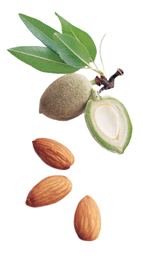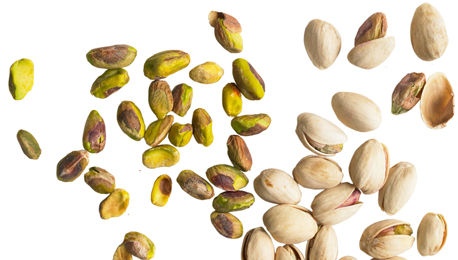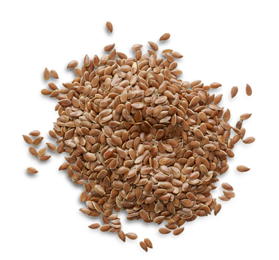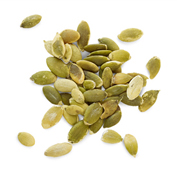
Perhaps the most remarkable thing about nuts and seeds is their heart-protecting quality. Eating fatty foods to lower your risk of heart disease may sound too good to be true, but that’s exactly what happens when you munch on nuts and seeds. They are among the richest sources of phytosterols—components of plant fats that lower cholesterol by blocking your absorption of it.
Nuts and seeds serve as a good protein source, too—most are at least ten percent protein—and are plentiful in other nutrients, like fiber and vitamin E. All in all, this dynamic duo is worth keeping on hand for a quick-energy snack or a crunchy addition to salads and more.


These nutrition-dense nuts actually grow inside a fuzzy fruit. Once the fruit ripens, it splits apart to expose a shell that hides the almond seed, which we know as the nut. Packed with vitamins, minerals, and unsaturated fats, this sweet nut benefits the heart, supports the immune system, and may reduce cancer risk.

Eating a handful of almonds a day can protect your heart. The almond’s monounsaturated and polyunsaturated fats help lower LDL (“bad”) cholesterol. Vitamin E fights inflammation and reduces the blood’s ability to clot, decreasing the risk of heart attack and coronary heart disease. For the most nutritional value, choose almonds with the skins on. The skin is where phytonutrients called flavonoids reside; they fight disease by enhancing the body’s immunity and helping prevent cell damage caused by environmental pollutants. The flavonoids anthocyanin and quercetin, in particular, may work to prevent stroke and urinary tract infections, fight inflammation, and reduce cancer risk. The almond’s hefty dose of protein and fiber contributes to its power-snack status; it keeps blood sugar steady and supports muscles and organs. Additionally, almonds provide bone-strengthening magnesium and calcium, and blood-supporting iron.
HOW TO BUY
Look for almonds sold in airtight containers or sealed bags. If buying from a bulk bin, ask your grocer about the turnover rate; the quicker, the better.
HOW TO STORE
Keep almonds in a tightly closed container in a cool, dry place. Raw whole almonds should stay fresh for two years, while roasted, slivered, sliced, and blanched almonds should keep for about one year (six months if the package is opened). The nuts will last even longer when refrigerated.
PREPARATION TIP
Even though you’ll lose some of the nutrients by blanching almonds, some recipes for baked goods call for them. To blanch your own, drop almonds into boiling water for 30 seconds. After draining, pop the skins off with your fingers. Or use regular almonds—the flavor will be the same.
DID YOU KNOW?
Emerging research shows that almonds may be prebiotic, meaning they may fuel the good bacteria in your gut—boosting your overall immune health.

recipes
Fresh Muesli with Apple and Almonds
Sablefish in Tomato-Saffron Stew
Panfried Trout with Almonds and Parsley
Whole-Wheat Spaghetti with Herb-Almond Pesto and Broccoli
Soba Noodle, Tofu, and Vegetable Stir-Fry


A native of North America, now grown mainly in Georgia and Texas, the pecan is the seed of a species of hickory tree. It has long been associated with Southern desserts like pie and pralines, but its rich, satisfying flavor makes it just as perfect for healthier fare such as salads, or as a snack all by itself.

A daily handful of pecans reduces your overall risk of heart disease. Unlike saturated fats, the unsaturated fats in pecans help to lower cholesterol levels, especially LDL (“bad”) cholesterol. Pecans also contain the amino acid L-arginine, which may improve the flexibility of artery walls and decrease the risk of arterial blood clots. Eating pecans also adds fiber and vitamin E to your diet.
HOW TO BUY
Buy unshelled pecans in the fall, their peak season, and look for shells with no cracks or blemishes. Make sure to buy shelled pecans in an airtight package.
HOW TO STORE
The best place to keep unshelled pecans is in an airtight container in the refrigerator (up to six months) or the freezer (up to one year). Keep shelled pecans well wrapped in a dry, cool spot up to three months (or six months in the freezer).
DID YOU KNOW?
Pecans’ high fat content makes them particularly prone to rancidity if bruised or exposed to light, heat, or moisture, so handle with care.



Grown in the American Southwest today, pistachios originated in central Asia, where the word for the open shell also means “laughing.” The vividly colored nuts have a buttery taste that makes them irresistible for snacking; they also add flavor, crunch, and a touch of sophistication to dishes both sweet and savory.

Rich in protein and fiber, pistachios are a great source of energy and are packed with antioxidants. They may even reduce the body’s response to stress, making them a wonderful workday treat. The nuts are high in potassium, which helps normalize blood pressure, maintain water balance in the body, and strengthen muscles. Like many other nuts, they contain healthy monounsaturated fats, which can help lower LDL (“bad”) cholesterol and prevent heart disease.
HOW TO BUY
Choose nuts with partially opened pale beige shells (avoid dyed pistachios), and purchase them from a store that has frequent turnover. Stick with unsalted pistachios to avoid added sodium, which counteracts the potassium present in the nuts.
HOW TO STORE
Keep nuts in an airtight container in the refrigerator for up to six months, or in the freezer for up to one year.
DID YOU KNOW?
Pistachios get their emerald hue from chlorophyll in the nut, the same compound that gives green leaves their color.



Depending on how you split a walnut in its shell, the nut resembles either a heart or a brain—which is so apt, really, since these nuts do wonders for both. Loaded with vitamin E and good-for-you fats, walnuts also help fight inflammation and protect the cardiovascular system.

Most nuts boast healthy oil, but walnuts have an added edge. They are the only nuts—and one of the few foods—that offer appreciable amounts of alpha-linolenic acid, or ALA, an omega-3 fatty acid. ALA, which the body can’t manufacture, protects the heart by improving your ratio of HDL (“good”) to LDL (“bad”) cholesterol and reducing inflammation, while playing a significant role in the development of the brain and cognitive function. Walnuts also provide a concentrated source of disease-fighting antioxidants, including gamma-tocopherol, a type of vitamin E.
HOW TO BUY
Because of their high polyun-saturated fat content, walnuts are more perishable than other nuts. Buy from sources with a high turnover, and choose nuts that are still in the shell if possible. If you do buy shelled walnuts, choose halves rather than pieces, as more cut or broken surfaces encourage oxidation.
HOW TO STORE
Store walnuts in an airtight container in the refrigerator (up to 6 months) or freezer (up to 1 year) to maximize freshness.
DID YOU KNOW?
Artists used to rely on walnut oil as a drying agent for paint because its slow drying time allowed for even application over a broad surface. The oil would form a solid film after long exposure to air, rendering colors rich and luminous with its translucency. In fact, Michelangelo used walnut oil in painting the Sistine Chapel.

recipes
Banana Bread with Walnuts and Flaxseed
Roasted Red Pepper and Walnut Dip
Greek Yogurt and Vegetable Sandwiches
Walnut-Crusted Chicken Breasts


Rich in fiber, phytochemicals, and omega-3 fatty acids, flaxseed is extremely nutritious. You can reap its rich rewards by eating only a tablespoon of ground flaxseed a day; add it to your oatmeal or an omelet for breakfast, or slip it into a peanut butter sandwich for lunch.

About the same size as sesame seeds, these shiny brown seeds are one of the richest sources of alpha-linolenic acid (ALA), an essential fatty acid in the omega-3 family, which provides anti-inflammatory benefits and protects against atherosclerosis, heart disease, and stroke. Flaxseed also contains a balance of soluble and insoluble fiber to help with digestion and cardiovascular health, and it’s an excellent source of lignans—phytoestrogens associated with lowered risk of hormone-related cancers, including breast cancer. To make the seed’s health benefits more available to your body, grind flaxseed before using it. Buy the seed whole and process a few tablespoons at a time using a spice grinder or a specialized flaxseed grinder. The high fat content of flaxseed can make it go rancid quickly once you break the hull, so use it immediately after grinding.
HOW TO BUY
Flaxseed comes in dark brown and golden varieties. To get the highest level of nutrients, buy whole flaxseed and make sure the store has a high turnover to ensure freshness. If purchasing preground flaxmeal, make sure it’s been vacuum-packed and kept refrigerated.
HOW TO STORE
To prevent oxidation, refrigerate or freeze whole or ground flaxseed in a tightly sealed container.
PREPARATION TIP
You can integrate more flax into your diet by mixing ground seeds into fruit smoothies, dark sauces, and stews. You can also incorporate flax into many baking recipes without diminishing its health benefits. For every cup of flour, try replacing ¼ cup with ground flax.
DID YOU KNOW?
Flaxseed comes from the same blue-flowered plant, Linum usitatissimum, that brings us linen fabric and the linseed oil used in woodworking.



More than just a thrifty snack scooped from a jack-o’-lantern, pumpkin seeds are a true nutritional treasure, rich in protein and minerals. Pumpkins yield large, flat seeds with a slightly chewy texture and a mellow, nutty flavor. Depending on the variety of the pumpkin, some of the olive-green seeds come encased in an edible white shell.

When the ancient Aztecs snacked on pumpkin seeds, they were on to something: Just a handful of these seeds offers a concentrated source of protein and energy-producing magnesium, along with generous amounts of immunity-protecting zinc. Abundant in phytosterols, which help lower cholesterol, pumpkin seeds also provide plenty of fiber when eaten in their shells.
HOW TO BUY
Scoop seeds from an actual pumpkin or buy the seeds raw or roasted, prepackaged or in bulk. “Pepitas” are also pumpkin seeds, typically hulled.
HOW TO STORE
Because of their high oil content, pumpkin seeds turn rancid easily, so refrigerate them in an airtight container and eat within a month or two. You can also freeze them for several months.
Roasted pumpkin seeds are delicious eaten out of hand or added to granola or trail mix. Toast them in a small skillet over medium, shaking pan occasionally, until just starting to darken, 2 to 3 minutes (be careful not to let them burn). Transfer to a plate to cool.
DID YOU KNOW?
You can roast and eat the seeds of any type of pumpkin, whether it’s a culinary pumpkin used to make a sweet pumpkin pie or a field pumpkin carved for Halloween.
